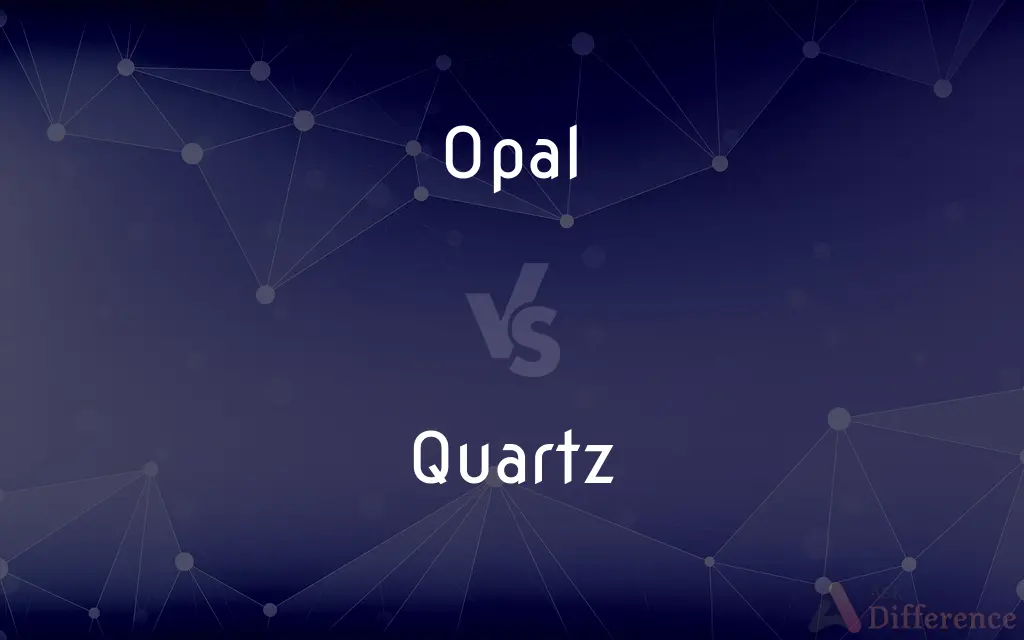Opal vs. Quartz — What's the Difference?
By Urooj Arif & Fiza Rafique — Updated on March 8, 2024
Opal is a hydrated silica gem with a play-of-color, whereas quartz is a hard, crystalline mineral often used in jewelry.

Difference Between Opal and Quartz
Table of Contents
ADVERTISEMENT
Key Differences
Opal is a unique gemstone known for its dazzling play-of-color, caused by internal diffraction of light. Whereas quartz is a widely abundant mineral that forms clear, well-defined crystals and comes in various colors and types, including amethyst and citrine.
Opal's water content can range from 3% to 21% by weight, which contributes to its characteristic appearance and fragility. On the other hand, quartz is known for its hardness (7 on the Mohs scale), making it more durable and suitable for a variety of jewelry and decorative items.
Opals are prized for their iridescence, where even slight movements can cause flashes of different colors. Quartz, while sometimes transparent or translucent, does not exhibit this play-of-color but may have unique inclusions or color zones that add to its beauty.
Quartz is often used in technological applications due to its piezoelectric properties, which means it can generate an electric charge under mechanical stress. Opal, due to its delicate nature and water content, is mainly valued as a gemstone for personal adornment.
The formation process of opal involves the deposition of silica gel from water, which then hardens over time. Quartz crystals form from molten magma or in hydrothermal veins, often in the presence of high temperatures and pressures.
ADVERTISEMENT
Comparison Chart
Composition
Hydrated silica with water content.
Crystalline silicon dioxide.
Hardness
5.5-6.5 on the Mohs scale.
7 on the Mohs scale.
Key Features
Play-of-color due to internal structures.
Clarity, various colors, and types.
Uses
Mainly as gemstones in jewelry.
Jewelry, decorative items, and technological applications.
Formation
Silica gel deposition from water.
Crystallizes from magma or hydrothermal veins.
Compare with Definitions
Opal
Characterized by its water content and dazzling iridescence.
The opal necklace she wore sparkled with every color of the rainbow.
Quartz
One of the most abundant minerals, known for its durability and clarity.
The quartz crystal was perfectly clear, showcasing its flawless structure.
Opal
Known for its unique internal color play caused by diffraction.
The opal's play-of-color was mesmerizing, changing with every movement.
Quartz
Includes well-known varieties like amethyst, citrine, and rose quartz.
The amethyst, a type of quartz, displayed a deep purple hue.
Opal
Each opal is unique, with patterns ranging from pinfire to broad flash.
The opal's broad flash pattern displayed large, sweeping colors.
Quartz
Forms under high temperatures and pressures, often in hexagonal crystals.
The quartz crystal formed deep within the earth, emerging as a perfect hexagonal prism.
Opal
Requires careful handling due to its water content and softer composition.
Handle opal jewelry gently to avoid drying out or cracking the gemstone.
Quartz
Utilized in electronics for its piezoelectric properties.
Quartz is a key component in watches and electronic circuits due to its stability.
Opal
Forms from the evaporation of silica-rich water in cracks and voids.
The opal formed over millennia as silica-laden water evaporated, leaving behind the precious gem.
Quartz
Popular in jewelry and as decorative items for its beauty and durability.
The quartz countertop was not only beautiful but also resistant to scratches and heat.
Opal
A mineral of hydrated silica.
Quartz
Crystal meth: methamphetamine hydrochloride.
Opal
Opal is a hydrated amorphous form of silica (SiO2·nH2O); its water content may range from 3 to 21% by weight, but is usually between 6 and 10%. Because of its amorphous character, it is classed as a mineraloid, unlike crystalline forms of silica, which are classed as minerals.
Quartz
Quartz is a hard, crystalline mineral composed of silica (silicon dioxide). The atoms are linked in a continuous framework of SiO4 silicon-oxygen tetrahedra, with each oxygen being shared between two tetrahedra, giving an overall chemical formula of SiO2.
Opal
A gemstone consisting of a form of hydrated silica, typically semi-transparent and showing many small points of shifting colour against a pale or dark ground
A large opal surrounded by small diamonds
An opal ring
Quartz
A very hard mineral composed of silica, SiO2, found worldwide in many different types of rocks, including sandstone and granite. Varieties of quartz include agate, chalcedony, chert, flint, opal, and rock crystal.
Opal
A gemstone made of this mineral, noted for its rich iridescence.
Quartz
(mineral) The most abundant mineral on the earth's surface, of chemical composition silicon dioxide, SiO2. It occurs in a variety of forms, both crystalline and amorphous. Found in every environment.
Opal
(mineral) A mineral consisting, like quartz, of silica, but inferior to quartz in hardness and specific gravity, of the chemical formula SiO2·nH2O.
Quartz
A form of silica, or silicon dioxide (SiO2), occurring in hexagonal crystals, which are commonly colorless and transparent, but sometimes also yellow, brown, purple, green, and of other colors; also in cryptocrystalline massive forms varying in color and degree of transparency, being sometimes opaque.
Opal
(gemology) A precious gem, an iridescent gemstone found in the opal-silica mineral substrate (potch)
Quartz
Colorless glass made of almost pure silica
Opal
A colloquial name used in molecular biology referring to a particular stop codon sequence, "UGA."
Quartz
A hard glossy mineral consisting of silicon dioxide in crystal form; present in most rocks (especially sandstone and granite); yellow sand is quartz with iron oxide impurities
Opal
Any of various lycaenid butterflies of the genus Nesolycaena.
Opal
A mineral consisting, like quartz, of silica, but inferior to quartz in hardness and specific gravity.
Opal
A translucent mineral consisting of hydrated silica of variable color; some varieties are used as gemstones
Common Curiosities
What makes quartz suitable for technological uses?
Quartz's piezoelectric properties, making it ideal for precision electronics.
Why is opal known for its play-of-color?
Opal's play-of-color is due to diffraction of light within its silica structure.
Are all quartz crystals clear?
Not all; quartz comes in various colors and types, some of which are translucent or colored.
How should opal jewelry be cared for?
Avoid exposure to dry environments and harsh chemicals to prevent cracking.
How does the water content affect opals?
Water content contributes to opals' unique appearance but also makes them more fragile.
Can opals be used in everyday jewelry?
Opals can be used in jewelry but require careful handling due to their delicate nature.
How is quartz different from opal in composition?
Quartz is crystalline silicon dioxide, lacking the water content found in opals.
Are synthetic opals and quartz available?
Yes, both gemstones can be synthetically produced, mimicking their natural counterparts.
What defines an opal gemstone?
Opal is defined by its hydrated silica composition and distinctive play-of-color.
What causes the color variations in quartz?
Color variations are due to impurities, irradiation, and the presence of other minerals.
What is the Mohs scale rating for opal?
Opal's hardness ranges from 5.5 to 6.5 on the Mohs scale.
What is the significance of opal's water content?
The water content not only influences opal's physical properties but also contributes to its unique visual effects.
What are some popular quartz varieties?
Popular types include amethyst, citrine, and rose quartz.
Is quartz only used in jewelry?
No, quartz is also used in decorative items and for its piezoelectric properties in electronics.
Can opal and quartz be found together?
While they form in different environments, opal and quartz can occasionally be found in the same geological regions.
Share Your Discovery

Previous Comparison
Belarusian vs. Russian
Next Comparison
Chiefly vs. PrimarilyAuthor Spotlight
Written by
Urooj ArifUrooj is a skilled content writer at Ask Difference, known for her exceptional ability to simplify complex topics into engaging and informative content. With a passion for research and a flair for clear, concise writing, she consistently delivers articles that resonate with our diverse audience.
Co-written by
Fiza RafiqueFiza Rafique is a skilled content writer at AskDifference.com, where she meticulously refines and enhances written pieces. Drawing from her vast editorial expertise, Fiza ensures clarity, accuracy, and precision in every article. Passionate about language, she continually seeks to elevate the quality of content for readers worldwide.














































